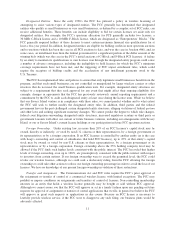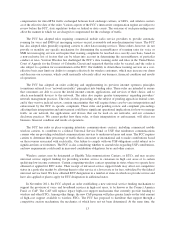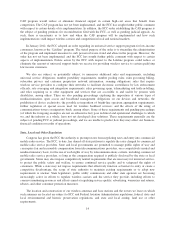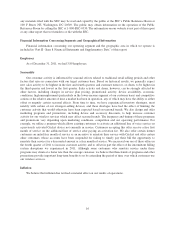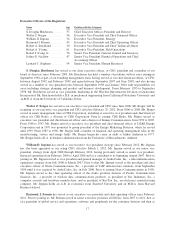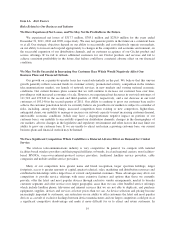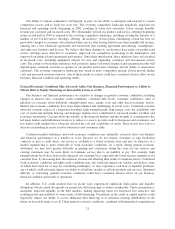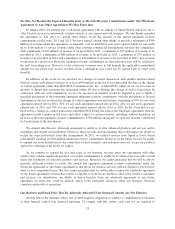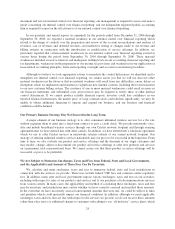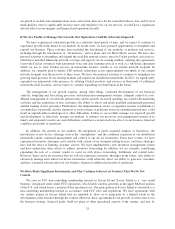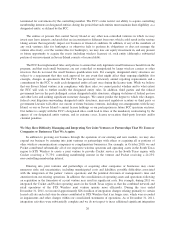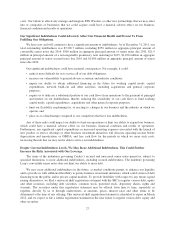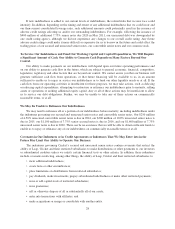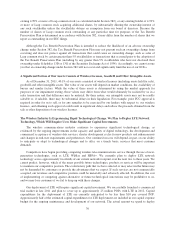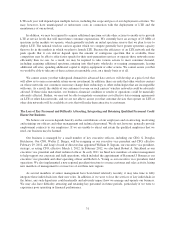Cricket Wireless 2011 Annual Report Download - page 31
Download and view the complete annual report
Please find page 31 of the 2011 Cricket Wireless annual report below. You can navigate through the pages in the report by either clicking on the pages listed below, or by using the keyword search tool below to find specific information within the annual report.Our ability to remain competitive will depend, in part, on our ability to anticipate and respond to various
competitive factors and to keep our costs low. The evolving competitive landscape negatively impacted our
financial and operating results beginning in 2009, resulting in fewer new customers, lower average monthly
revenue per customer and increased costs. We substantially revised our product and service offerings beginning
in the second half of 2010 to respond to the evolving competitive landscape, including revising the features of a
number of our Cricket service offerings, offering “all-inclusive” service plans, eliminating certain late fees we
previously charged to customers who reinstated their service after having failed to pay their monthly bill on time,
entering into a new wholesale agreement and nationwide data roaming agreement and offering “smartphones”
and other new handsets and devices. We believe that these changes to our business have made our product and
service offerings more attractive to customers, improved our competitive positioning in the marketplace and
improved our financial and operational performance. Since their introduction, these initiatives have also resulted
in increased costs, including equipment subsidy for new and upgrading customers and incremental service
costs. The extent to which these initiatives will positively impact our future financial and operational results will
depend upon continued customer acceptance of our product and service offerings and our ability to retain these
customers. The evolving competitive landscape may result in more competitive pricing, slower growth, higher
costs and increased customer turnover. Any of these results or actions could have a material adverse effect on our
business, financial condition and operating results.
General Economic Conditions May Adversely Affect Our Business, Financial Performance or Ability to
Obtain Debt or Equity Financing on Reasonable Terms or at All.
Our business and financial performance are sensitive to changes in general economic conditions, including
changes in interest rates, consumer credit conditions, consumer debt levels, consumer confidence, rates of
inflation (or concerns about deflation), unemployment rates, energy costs and other macro-economic factors.
Market and economic conditions have been unprecedented and challenging in recent years. Continued concerns
about the systemic impact of a long-term downturn, high unemployment, high energy costs, the availability and
cost of credit and unstable housing and mortgage markets have contributed to increased market volatility and
economic uncertainty. Concern about the stability of the financial markets and the strength of counterparties has
led many lenders and institutional investors to reduce or cease to provide credit to businesses and consumers, and
less liquid credit markets have adversely affected the cost and availability of credit. These factors have led to a
decrease in spending in recent years by businesses and consumers alike.
Continued market turbulence and weak economic conditions may materially adversely affect our business
and financial performance in a number of ways. Because we do not require customers to sign fixed-term
contracts or pass a credit check, our service is available to a broad customer base and may be attractive to a
market segment that is more vulnerable to weak economic conditions. As a result, during general economic
downturns, we may have greater difficulty in gaining new customers within this base for our services and
existing customers may be more likely to terminate service due to an inability to pay. For example, high
unemployment levels have historically impacted our customer base, especially the lower-income segment of our
customer base, by decreasing their discretionary income and affecting their ability to maintain service. Continued
weak economic conditions and tight credit conditions may also adversely impact our vendors and dealers, some
of which have filed for or may be considering bankruptcy, or may experience cash flow or liquidity problems,
any of which could adversely impact our ability to distribute, market or sell our products and services. Sustained
difficult, or worsening, general economic conditions could have a material adverse effect on our business,
financial condition and results of operations.
In addition, U.S. credit markets have in recent years experienced significant dislocations and liquidity
disruptions which caused the spreads on prospective debt financings to widen considerably. These circumstances
materially impacted liquidity in the debt markets, making financing terms for borrowers less attractive and
resulting in the unavailability of some forms of debt financing. Uncertainty in the credit or capital markets could
negatively impact our ability to access additional debt financing or to refinance existing indebtedness in the
future on favorable terms or at all. These general economic conditions, combined with intensified competition in
21


